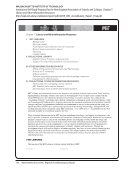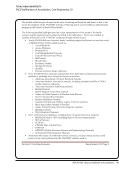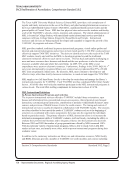SPEC Kit 330: Library Contribution to Accreditation · 173
University of Virginia
Core Requirements 2.9 – Learning Resources and Services
http://www.virginia.edu/sacs/core/2-9.html
Core Requirements, Institutional Accreditation, U.Va.
http://www.virginia.edu/sacs/core/2-9.html[9/5/12 4:51:12 PM]
management, and coordination of selectors. Within the central University Library, more than 30 subject librarians
manage over 300 funds accounting for $7 million of the $10 million collections budget. The subject librarians serve as
liaisons to academic departments and programs in a decentralized manner, working with faculty and students to
obtain library resources that meet their curricular and research needs. The University Library maintains subject guides
relevant to each academic department that identify Internet and print resources located at the University and
elsewhere.
The library determines the adequacy of its collections and its learning/information resources through review of user
needs, as indicated through user requests regular interactions between the various schools and the library’s
departmental liaisons regular review of the University’s academic programs and services review of course curricula
by the library’s subject area specialists and review of use statistics required by the Association of Research Libraries
Standards for Libraries in Higher Education.
The Library’s Management Information Services group is responsible for coordinating the gathering and reporting of
management information throughout the library. The group uses the Library's Balanced Scorecard to provide specific
metrics to determine the health and success of the organization. The metrics provide a view of the library organization
from four perspectives: user, internal processes, financial, and future/learning potential. Results are reported to the
library staff, are reviewed annually by the Library administration, and are used to evaluate and improve the
performance of the Library.
One of the goals of the Management Information Services group is to assist with analyzing and evaluating library
services and collections. For example, the following two metrics demonstrate that the Library is setting and meeting
appropriate goals in these areas.
Metric: The University Library strives to respond to the needs of its users in a timely fashion. Goal: The
library has set an ambitious standard of filling requests for new materials: if a faculty member or student
places a request for a title, the Library’s goal is to have it in his or her hands in seven days. Success: In the
2005 fiscal year, the University Library succeeded in meeting this goal 62 percent of the time for books
published in North America.
Metric: In materials acquisition, the library gives priority to the research and curricular needs of current faculty
and students. Goal: Reflecting this, it has set a goal that 50-60 percent of newly cataloged monographs
should circulate within two years. Success: In the 2005 fiscal year, 59 percent of the books purchased two
years earlier had circulated.
The University Library also assesses the adequacy of its collections and its learning/information resources during the
annual review of its collections, collection size, number and types of resources, and expenditures in preparation for the
University budget cycle.
The Health Sciences Library
The primary responsibility for selecting resources rests with the Health Science Library's Collection Development
Committee. This committee determines the adequacy of the library’s collections by adhering to its Collection
Development Policy, which explains the criteria used when selecting materials and resources for the collection. The
Assistant Director for Collection Development chairs the committee, which comprises members from all Library
departments. Committee decisions are guided by the expert advice of other Library staff, the recommendations and
advice from library patrons, analysis of interlibrary loan use patterns, and the Library’s Mission. The Collection
Development Committee prepares an annual Collections Budget that includes all of the print and online materials
purchased or licensed by the Library.
Currently 43 percent ($1.8 million) of the library's operating budget is allocated for purchasing resources for the
collection. On average the library spends 75 percent of the collections budget on print and online journals, with the
balance spent on monographs (books), standing orders (e.g., reference materials), site licenses for online databases,
journals, computer software, and audiovisuals. The collections budget also includes a subsidy of the library's
interlibrary loan/document delivery services. In recent years, there has been a greater emphasis on acquiring/licensing
resources in electronic form, which is expected to continue. Some of the electronic collection budget items are planned
in conjunction with the Alderman Library Acquisitions Department, and the cost is shared proportionally.
The Law Library
The Law Library’s Collection Development Policy presents guidelines for areas of selection, collection size, and scope.
The Law Library Director, guided by the Collection Development Policy and in consultation with faculty of the School of
Law, works with a committee of selectors composed of individual librarians. The Law Library encourages School of Law
faculty recommendations for purchase and frequently consults directly with faculty regarding selection decisions. The
Law Library also welcomes student selection recommendations. As a member of the Federal Depository Library
Program, the Law Library complies with the Government Printing Office’s rules and recommendations for collection
development and access.
The Law Library assesses its collection through user surveys, focus groups, faculty interviews, and participation in the
American Bar Association Annual Survey and the Association of Research Libraries survey.
The Graduate School of Business Administration Library
This library assesses its collection through user surveys, faculty interviews, an annual comparative review of
collections among graduate business school members of the Academic Business Library Directors, as well as
participation in the Association of Research Libraries annual survey.
5. Access and User Privileges
The University of Virginia’s Library System uses VIRGO to provide online access to the University Library Catalog with
keyword searches searches by author, title, journal title, and subject and call numbers. Online help screens and
printed materials provide directions for using VIRGO effectively, and include instructions for accessing VIRGO from
home and office computers. Find@UVA, Journal Finder and Article Finder are tools that provide all patrons with online
access to over 90 licensed indexing and abstracting services providing access to over 40,000 journal titles. VIRGO
provides access to over one hundred bibliographic and full text databases, such as Lexis-Nexis, WorldCat, Infotrac,
Dissertation Abstracts, MLA Bibliography, and Web of Science. Non-University patrons are provided temporary guest
passwords to gain access to VIRGO.
The University of Virginia Libraries seek to provide all patrons with a welcoming, comfortable, and safe environment
that promotes free intellectual exploration, research, and learning (for example, see the University Library’s Vision and
Guiding Principles). Although each library primarily provides facilities and services for their school, all libraries welcome
faculty, students, staff, researchers, alumni, members of the University community, and the general public. Library
information, circulation, and eligibility policies set out guidelines on library access and user privileges to collections,
resources, and services (See the University Library Circulation Policy, the Health Sciences Library User Eligibility Policy,
the Law Library’s Circulation and Access Policies). Information is disseminated through library web sites, in paper
publications and brochures through meetings with the Faculty Senate, the University Libraries Committee, the Library
University of Virginia
Core Requirements 2.9 – Learning Resources and Services
http://www.virginia.edu/sacs/core/2-9.html
Core Requirements, Institutional Accreditation, U.Va.
http://www.virginia.edu/sacs/core/2-9.html[9/5/12 4:51:12 PM]
management, and coordination of selectors. Within the central University Library, more than 30 subject librarians
manage over 300 funds accounting for $7 million of the $10 million collections budget. The subject librarians serve as
liaisons to academic departments and programs in a decentralized manner, working with faculty and students to
obtain library resources that meet their curricular and research needs. The University Library maintains subject guides
relevant to each academic department that identify Internet and print resources located at the University and
elsewhere.
The library determines the adequacy of its collections and its learning/information resources through review of user
needs, as indicated through user requests regular interactions between the various schools and the library’s
departmental liaisons regular review of the University’s academic programs and services review of course curricula
by the library’s subject area specialists and review of use statistics required by the Association of Research Libraries
Standards for Libraries in Higher Education.
The Library’s Management Information Services group is responsible for coordinating the gathering and reporting of
management information throughout the library. The group uses the Library's Balanced Scorecard to provide specific
metrics to determine the health and success of the organization. The metrics provide a view of the library organization
from four perspectives: user, internal processes, financial, and future/learning potential. Results are reported to the
library staff, are reviewed annually by the Library administration, and are used to evaluate and improve the
performance of the Library.
One of the goals of the Management Information Services group is to assist with analyzing and evaluating library
services and collections. For example, the following two metrics demonstrate that the Library is setting and meeting
appropriate goals in these areas.
Metric: The University Library strives to respond to the needs of its users in a timely fashion. Goal: The
library has set an ambitious standard of filling requests for new materials: if a faculty member or student
places a request for a title, the Library’s goal is to have it in his or her hands in seven days. Success: In the
2005 fiscal year, the University Library succeeded in meeting this goal 62 percent of the time for books
published in North America.
Metric: In materials acquisition, the library gives priority to the research and curricular needs of current faculty
and students. Goal: Reflecting this, it has set a goal that 50-60 percent of newly cataloged monographs
should circulate within two years. Success: In the 2005 fiscal year, 59 percent of the books purchased two
years earlier had circulated.
The University Library also assesses the adequacy of its collections and its learning/information resources during the
annual review of its collections, collection size, number and types of resources, and expenditures in preparation for the
University budget cycle.
The Health Sciences Library
The primary responsibility for selecting resources rests with the Health Science Library's Collection Development
Committee. This committee determines the adequacy of the library’s collections by adhering to its Collection
Development Policy, which explains the criteria used when selecting materials and resources for the collection. The
Assistant Director for Collection Development chairs the committee, which comprises members from all Library
departments. Committee decisions are guided by the expert advice of other Library staff, the recommendations and
advice from library patrons, analysis of interlibrary loan use patterns, and the Library’s Mission. The Collection
Development Committee prepares an annual Collections Budget that includes all of the print and online materials
purchased or licensed by the Library.
Currently 43 percent ($1.8 million) of the library's operating budget is allocated for purchasing resources for the
collection. On average the library spends 75 percent of the collections budget on print and online journals, with the
balance spent on monographs (books), standing orders (e.g., reference materials), site licenses for online databases,
journals, computer software, and audiovisuals. The collections budget also includes a subsidy of the library's
interlibrary loan/document delivery services. In recent years, there has been a greater emphasis on acquiring/licensing
resources in electronic form, which is expected to continue. Some of the electronic collection budget items are planned
in conjunction with the Alderman Library Acquisitions Department, and the cost is shared proportionally.
The Law Library
The Law Library’s Collection Development Policy presents guidelines for areas of selection, collection size, and scope.
The Law Library Director, guided by the Collection Development Policy and in consultation with faculty of the School of
Law, works with a committee of selectors composed of individual librarians. The Law Library encourages School of Law
faculty recommendations for purchase and frequently consults directly with faculty regarding selection decisions. The
Law Library also welcomes student selection recommendations. As a member of the Federal Depository Library
Program, the Law Library complies with the Government Printing Office’s rules and recommendations for collection
development and access.
The Law Library assesses its collection through user surveys, focus groups, faculty interviews, and participation in the
American Bar Association Annual Survey and the Association of Research Libraries survey.
The Graduate School of Business Administration Library
This library assesses its collection through user surveys, faculty interviews, an annual comparative review of
collections among graduate business school members of the Academic Business Library Directors, as well as
participation in the Association of Research Libraries annual survey.
5. Access and User Privileges
The University of Virginia’s Library System uses VIRGO to provide online access to the University Library Catalog with
keyword searches searches by author, title, journal title, and subject and call numbers. Online help screens and
printed materials provide directions for using VIRGO effectively, and include instructions for accessing VIRGO from
home and office computers. Find@UVA, Journal Finder and Article Finder are tools that provide all patrons with online
access to over 90 licensed indexing and abstracting services providing access to over 40,000 journal titles. VIRGO
provides access to over one hundred bibliographic and full text databases, such as Lexis-Nexis, WorldCat, Infotrac,
Dissertation Abstracts, MLA Bibliography, and Web of Science. Non-University patrons are provided temporary guest
passwords to gain access to VIRGO.
The University of Virginia Libraries seek to provide all patrons with a welcoming, comfortable, and safe environment
that promotes free intellectual exploration, research, and learning (for example, see the University Library’s Vision and
Guiding Principles). Although each library primarily provides facilities and services for their school, all libraries welcome
faculty, students, staff, researchers, alumni, members of the University community, and the general public. Library
information, circulation, and eligibility policies set out guidelines on library access and user privileges to collections,
resources, and services (See the University Library Circulation Policy, the Health Sciences Library User Eligibility Policy,
the Law Library’s Circulation and Access Policies). Information is disseminated through library web sites, in paper
publications and brochures through meetings with the Faculty Senate, the University Libraries Committee, the Library
























































































































































































